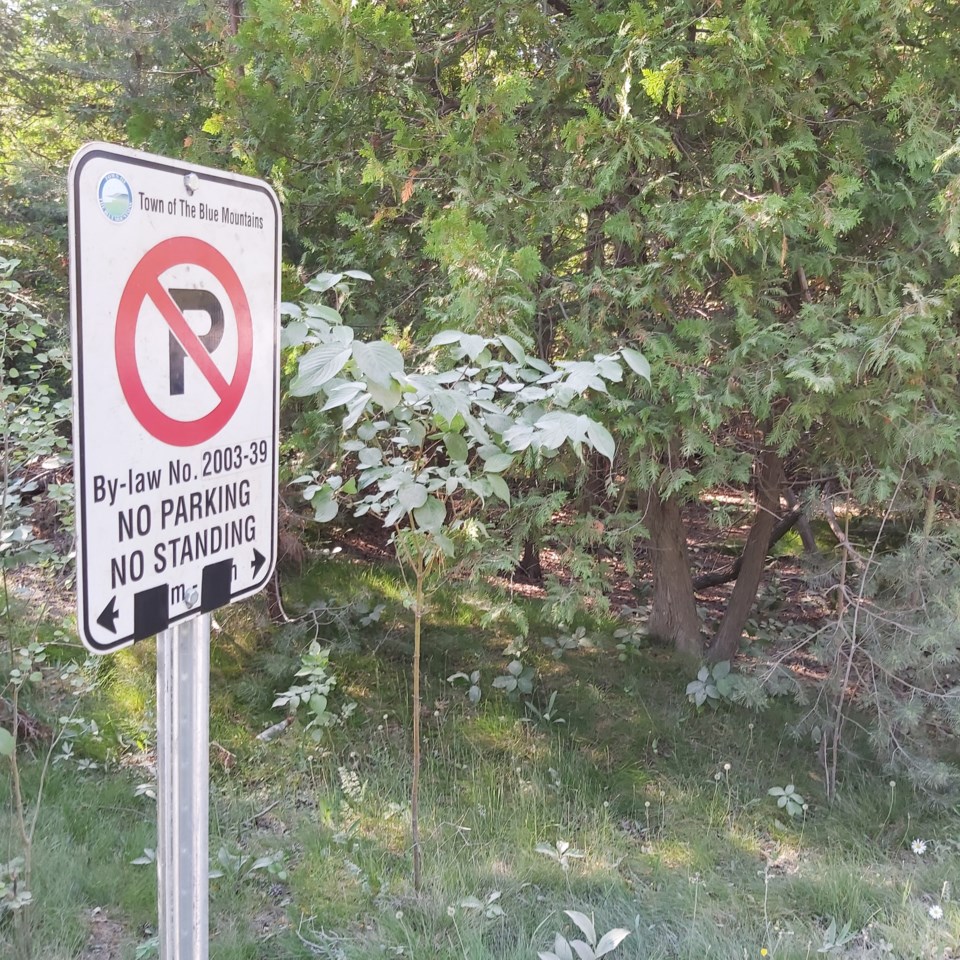A local trail club has expressed concern about a proposed parking bylaw in The Town of The Blue Mountains (TBM), which would bring increased parking restrictions to many of the town’s roadways.
The bylaw was developed in response to increased local traffic throughout the pandemic, and it was brought to a public meeting for input March 7.
“We brought in a number of temporary parking restrictions throughout town in response to the COVID pandemic to try and mitigate a number of issues, including overcrowding in places like beaches and trailheads, and really addressing what became … a series of major increases in popularity for our recreational areas,” said director of legal services Will Thomson.
The proposed bylaw would regulate numerous streets and parking zones throughout TBM, with parking banned on a number of streets.
Speaking on behalf of the Beaver Valley Bruce Trail Club, Bruce King brought forward concerns about restrictive parking measures at access points to hiking trails, due to a lack of available parking at some locations.
“Realistically, roadside parking is going to continue to be an important way that people can get access to the Bruce Trail and enjoy the Niagara escarpment,” King said. “Overly restrictive parking policies will reduce the opportunities for healthy outdoor recreation and nature appreciation, and the impact of very restrictive policies goes beyond just the Bruce Trail.”
“Roadside parking is important for the Kolapore trails, it's important for the mountain bikers over at Pretty River Valley, so … I think it's important to make sure that balance is carefully considered in different specific locations,” King said.
“One site-specific concern that I would like to raise is the proposed new prohibition on parking on the 18th Side Road, between Fifth and Sixth lines."
“Parking on that road provides access to a popular loop trail, the Margaret Paul Side Trail,” he said. “There are portions of that road where parking prohibition is probably reasonable, but our club thinks that a year-round prohibition on the entire road segment is overly restrictive.”
King also requested parking exemptions for workers carrying out trail maintenance.
“My club is also concerned the parking restrictions will make trail maintenance more difficult when access is needed for a variety of projects, including fallen tree removal, bridge construction and maintenance, brush cutting and new trail construction,” he said. “We ask that the town establish some simple system for permitting trail workers to park temporarily at suitable portions of areas that have parking restrictions.”
Thomson pointed out that some roads are more difficult to regulate when they have a limited amount of intersections, but he said the town is working on solutions.
“It's easy if we're regulating parking between Street A and Street B,” he said. “But then there are roads like Pretty River Road, it winds and it turns and it goes uphill and downhill, but there are no side roads between it for a large portion.”
“We can't simply say no parking on both sides between X Street and Y Street, we have to find a way to refine that,” he said. “One thing we're considering is no parking, except where signed, or parking is permitted where signed.”
Coun. Andrea Matrosovs suggested the trail club might work with the town to expand parking opportunities at popular outdoor recreation locations.
“I certainly favour the town working with groups like yourselves [and] the Ministry of Natural Resources, as well, to try to create parking lots where our biggest parking problems are, so that there can be proper facilities to receive visitors,” she said.
“I think both the local Bruce Trail clubs and the overall Bruce Trail Conservancy would be very much interested in working with the municipality, and the problem is some of the real hotspot areas are provincial parks,” King said.
On top of parking restrictions along many of the town’s roadways, the proposed bylaw would bring two other changes to the town’s current parking regulations.
Fines would increase from the current rate of $15-$27 per infraction to $50-$300 per infraction, with the $300 fine reserved for serious offences, such as parking within three metres of a fire hydrant or parking in a designated accessible parking space.
“[Fines of] $15 to $27 have become, and we've been told this by people parking in our municipality, just the cost of parking,” Thomson said. “Being able to hike or cycle in a world-class destination and having to pay $15 to $27 is the price of admission.”
Enforcement of the fines would be brought out of the provincial offences system and into an administrative monetary penalty system, which would give the town the ability to set its own fines, and would reduce the time required to process fines.
No decisions have been made yet regarding the proposed parking bylaw.
Thomson said he hopes to bring back a report incorporating public comments to council later in the spring.
“I'm anticipating that report in April,” he said. “I would really like to see these restrictions in force by the May long weekend at the latest so I'm hoping to get a draft in front of council and the public with some of these refinements and changes.”



